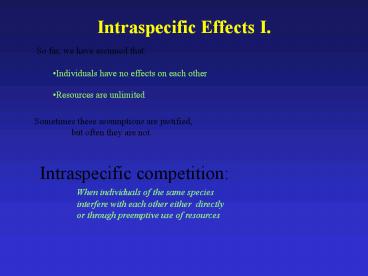Intraspecific Effects I. - PowerPoint PPT Presentation
1 / 22
Title:
Intraspecific Effects I.
Description:
Intraspecific Effects I. So far, we have assumed that: Individuals have no effects on each other Resources are unlimited Sometimes these assumptions are justified, – PowerPoint PPT presentation
Number of Views:84
Avg rating:3.0/5.0
Title: Intraspecific Effects I.
1
Intraspecific Effects I.
So far, we have assumed that
- Individuals have no effects on each other
- Resources are unlimited
Sometimes these assumptions are justified, but
often they are not.
Intraspecific competition When individuals of
the same species interfere with each other
either directly or through preemptive use of
resources
2
Characteristics of Intraspecific Competition
- The ultimate effect is a decrease in either
- reproduction or survival (decrease in the
- contribution to the next generation).
3
Characteristics of Intraspecific Competition
- The resource for which individuals are
- competing must be in short supply.
- Competing individuals are inherently
- equivalent (e.g., circumstances, more
- than individual differences, determines
- who wins).
4
Characteristics of Intraspecific Competition
- The effects of intra-specific competition
- are density dependent.
Density dependence The greater the number of
individuals, the greater the probability any
given individual will be adversely affected.
5
Density dependence
Not all DD effects are a result of
intra-specific competition.
They can arise from other processes such
as inter-specific competition.
Density dependence tends to regulate population
size.
6
Scramble and Contest Competition
- These are the theoretical extremes originally
- proposed by the ecologist A.J. Nicholson
- in 1954.
- Scramble All individuals get an equal
- share of resources
- Contest A few winners get all the
- resources, the remaining individuals
- get nothing.
7
Scramble competition
(From Begon et al. 1996)
8
Size-Symmetric Competition in Plants
- This is the equivalent of scramble competition
- in animals
- Also known as two-sided competition
- Resources are utilized in proportion to an
- individual plants size
Example soil nutrients are usually taken up in
a size-symmetric manner
9
Contest Competition
(From Begon et al. 1996)
10
Size-Asymmetric Competition in Plants
- Equivalent to contest competition in animals
- Also known as one-sided competition
- Resources are disproportionately used by
- larger individuals
Example light is often taken up in a
size- asymmetric manner the bigger plant gets
most or all, smaller plant dies
11
Are these extremes reasonable?
Probably not.
However, illustrate the range of
possible responses by real individuals.
12
Intraspecific Competition in Plants
Law of constant final yield
- This is a form of intraspecific competition
- Survival is not decreased, but plant size,
- and reproductive output, are affected.
- This relationship compares plots of different
- densities at a single instant of time it is
- not a dynamic process.
13
Self-thinning in plants
As plants grow in size, density-dependent mortali
ty may start to occur.
This is a dynamic process known as self-thinning
14
The -4/3 Thinning Law
(From Silvertown and Charlesworth 2001)
15
The -4/3 Thinning Law
(Silvertown and Charlesworth 2001)
16
Size Hierarchies Under Crowded Conditions
In both plants and animals, dense
populations tend to lead to many small
individuals but only a few large ones.
This is a result of intra-specific
competition and can occur even if all
organisms start out the same size initially.
17
Size Distributions Examples
(Silvertown and Charlesworth 2001)
18
Size Distributions Examples
(Vandermeer and Goldberg 2003)
19
Review
Intraspecific competition is characterized by
four conditions
- Decrease in demographic rates
- With increasing density
- A critical resource must be in
- Limiting supply
3. Individuals are inherently equivalent
4. The effects of intraspecific competition are
density dependent.
20
Review
Density dependence tends to regulate population
size.
Two forms of intraspecific competition are
scramble competition and contest competition in
plants
These are equivalent to size symmetric and size
asymmetric in plants
21
Review
In plants, the Law of Constant Final
Yield describes a pattern of decreasing
size and reproduction, but no mortality, with
increasing density
At a certain threshold, mortality will increase
This process is known as Self-Thinning
The slope of the relationship is
generally described by -3/2 or -4/3
22
Review
Self-thinning usually is called the -3/2
thinning law or the -4/3 thinning law
Intraspecific competition in both plants and
animals leads to size hierarchies































